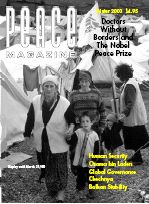
Peace Magazine Winter 2000, page 29. Some rights reserved.
Search for other articles by Susan Jagminas here
Film review
Many would agree that the Holocaust should be included as one of the most significant events of this century in those "top-ten" retrospective lists. It is a sad reality to acknowledge that one of the lowest points in our history is also one we can't forget. To some, keeping this memory alive is important in ensuring that similar atrocities never occur again. To others, keeping this memory alive is important so long as the memories are subject to censorship.
The latter believe that movies made about the Holocaust should be subject to restrictions of artistic license and constrained to hostorical accuracy.
Dr. Stuart Liebman, professor and chair of the department of media studies at the City University of New York, holds this view. In November, Liebman engaged Dr. Judy Doneson, a professor from Washington University in St. Louis, Missouri, in a debate about the 1998 Roberto Benigni film, Life is Beautiful. He wondered if it did justice to the memory of the Holocaust. The debate at the Beth Tzedec Congregation in Toronto drew an audience so unexpectedly large that the venue had to be relocated to the sanctuary in order to accommodate all the guests. Attendance topped 500. Judging by the size of the audience, and the topic of discussion, a lively exchange was expected. Unfortunately, this was not the case.
Dr. Liebman started off with what sounded like a well-researched and written argument, but its highly academic nature made it unintelligible to the average audience. In essence, his argument called for greater responsibility on the behalf of film-makers to portray historical events with realism and accuracy. Liebman believes Benigni's defence of the film, as a fable with inherent artistic freedom, does not apply particularly because the film uses an event as extraordinary as the Holocaust. Unrestricted artistic license distorts and trivializes the experience and evades history. To Liebman, any movie that uses the Holocaust, even as a backdrop, necessarily raises limitations on its artistic freedom.
Doneson's rebuttal lacked clarity and focus, and was presented with reservation (no doubt a response to the large audience which included its share of Holocaust survivors). What she managed to convey was insightful and convincing. Her main point was that the movie did indeed do justice to the Holocaust, not in anything having to do with its historical accuracy, which isn't the purpose of popular culture, but in being the first movie to bring a human face to a Jewish victim. She said this was a movie where a Jew wasn't just a passive victim, but a proactive one in that horrific situation. Doneson cited movies such as Schindler's List and Diary of Anne Frank as problematic in terms of historical accuracy. She suggested the audience look at the broad context within which the movie operated, rather than simply considering the movie on its own.
Doneson seemed to have ignored the complaints leveled against the movie as a comedy, and its lighthearted treatment, because she simply didn't find it funny, but rather "deeply and profoundly disturbing."
The usual questions ended the debate, but only one added another dimension. One audience participant suggested we view the film as a love story - about the intense love of a father for his child.
Regardless of which side one might lean toward, the Holocaust has been the subject of intense and sustained analysis, from the establishment of institutes and academic departments to hundreds of published books and articles, down to, yes, movies and other popular culture media.
The fact that popular culture has taken on that theme suggests at least one thing: the Holocaust has not been forgotten, regardless of the accuracy of its portrayal and treatment. To require historical accuracy and limit artistic freedom in movies such as Life is Beautiful is to validate them as a legitimate source of historical knowledge.
Susan Jagminas is a contributing editor at Peace Magazine and a pop-culture consumer.

Peace Magazine Winter 2000, page 29. Some rights reserved.
Search for other articles by Susan Jagminas here